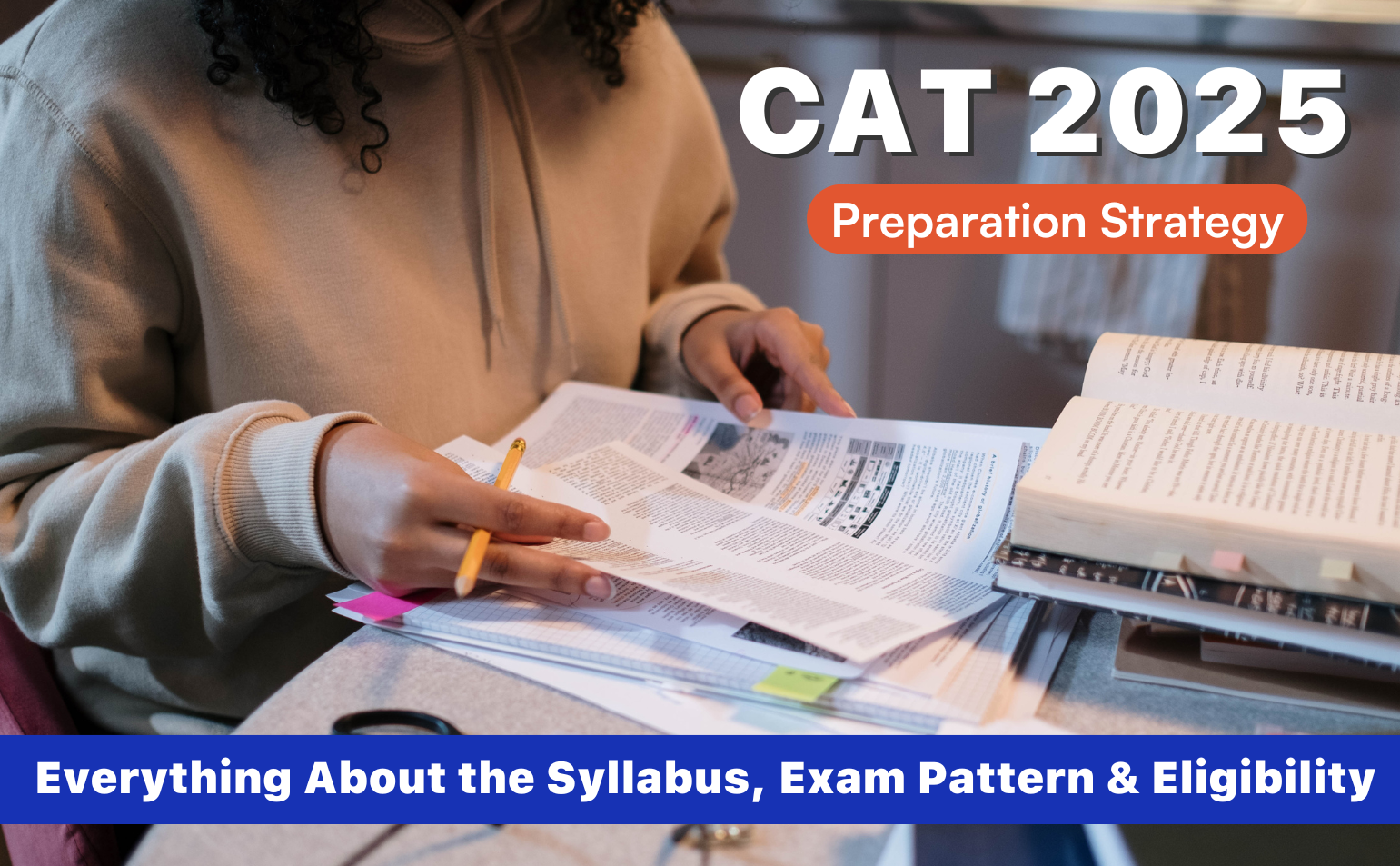It’s no wonder that preparing for one of the nations toughest exam CAT requires a well-structured strategy, a deep understanding of the syllabus, exam pattern, and eligibility criteria, along with effective time management and problem-solving skills. With CAT 2025 expected to follow a similar format as previous years, aspirants must develop a targeted study plan that covers all essential topics while focusing on practice and accuracy.
This comprehensive blog will provide a detailed preparation strategy for CAT 2025, including insights into the exam pattern, syllabus breakdown, study resources, time management tips, and expert-recommended strategies. Whether you’re a first-time aspirant or retaking the exam, following the right approach can significantly boost your chances of scoring a 99+ percentile.
Let’s start by understanding the fundamentals of CAT 2025 and complete preparation strategy.
Fundamentals of CAT 2025
The Common Admission Test (CAT) is a national-level management entrance exam conducted annually by one of the Indian Institutes of Management (IIMs) on a rotational basis. It serves as the primary gateway to prestigious MBA programs across India, including the IIMs, FMS Delhi, SPJIMR, MDI Gurgaon, and other top B-schools.
CAT is a computer-based test (CBT) that evaluates candidates on logical reasoning, quantitative aptitude, and verbal ability. Since it follows a percentile-based scoring system, a high percentile increases the chances of admission into top-tier MBA programs.
CAT 2025 Preparation Strategy & Study Plan
A well-structured study plan is essential for covering the entire syllabus and improving accuracy and speed. Aspirants should divide their preparation into three phases:
Phase 1: Concept Building (4-5 months)
- Focus on understanding basic concepts of QA, VARC, and DILR.
- Solve topic-wise questions daily to build a strong foundation.
- Develop a reading habit to improve comprehension skills.
- Use standard CAT preparation books like Arun Sharma’s CAT series and Nishit K. Sinha’s Logical Reasoning & Data Interpretation.
Phase 2: Practice & Accuracy Improvement (3 months)
- Start attempting sectional tests to track progress.
- Focus on time-bound problem-solving to enhance speed.
- Identify weak areas and revise concepts accordingly.
- Solve at least 10-15 DILR sets per week to get comfortable with complex puzzles.
Phase 3: Mock Tests & Performance Analysis (Last 2-3 months)
- Attempt full-length mock tests every 3-4 days and analyze mistakes.
- Improve time management and question selection strategies.
- Focus on revising shortcuts and formulas for quick calculations.
- Maintain accuracy over speed—avoid guesswork to minimize negative marking.
Daily Study Schedule for CAT Aspirants
This study schedule can be adjusted based on the student’s capabilities and availability.
| Time Slot | Activity |
| 6:30 AM – 8:00 AM | Reading newspapers/articles (VARC improvement) |
| 10:00 AM – 12:00 PM | Solve QA problems (Concept building + Speed practice) |
| 3:00 PM – 5:00 PM | DILR practice (Puzzle-solving & cases) |
| 7:00 PM – 9:00 PM | Mock test/Sectional test analysis |
| Before Bed | Revise formulas and shortcuts & analyze mistakes |
A structured study plan and consistent practice will help aspirants maximize their CAT percentile.
CAT 2025 Syllabus Breakdown
CAT does not have a predefined syllabus, but based on exams from previous years, we can categorize the topics covered under each section. A strong understanding of these topics is essential for scoring well.
Detailed CAT 2025 Syllabus
| Section | Description |
| Verbal Ability & Reading Comprehension (VARC) | Passages from diverse fields with questions on understanding, inference, reasoning, vocabulary, and grammar. Sentence correction, para jumbles, summary, critical reasoning. |
| Data Interpretation & Logical Reasoning (DILR) | Analyse data presented in tables, charts, and graphs to answer questions on trends, comparisons, calculations, and inferences. Solve puzzles, seating arrangements, blood relations, syllogisms, and other logical reasoning problems. |
| Quantitative Ability (QA) | Solve problems based on percentages, profit & loss, interest, time & work, ratio & proportion, mixtures, and averages. Solve linear & quadratic equations, inequalities, functions. Apply concepts of lines, angles, shapes, coordinate geometry, and mensuration. Analyse problems using probability, permutations & combinations, and set theory. Understand divisibility, HCF, LCM, surds, and indices. |
Section-Wise Preparation Approach:
VARC Preparation Strategy:
- Focus on reading comprehension (RC) as it contributes 70% of the section.
- Practice para jumbles and para summaries to improve logical structuring skills.
- Read newspapers (The Hindu, The Economist) daily to enhance comprehension speed and vocabulary.
DILR Preparation Strategy:
- Solve at least 2-3 DI/LR sets daily to improve logical reasoning ability.
- Practice different types of graphs, charts, and arrangement-based puzzles.
- Focus on understanding data sufficiency and pattern recognition.
QA Preparation Strategy:
- Start with basic arithmetic (percentages, profit & loss, time-speed-distance) before moving to algebra and geometry.
- Strengthen your calculation speed by practising mental math techniques.
- Solve mock tests and analyze mistakes to identify weak areas.
Since the CAT syllabus is vast and requires a conceptual approach, aspirants should focus on building a strong foundation in each section before moving on to advanced problem-solving techniques.
Exam Pattern of CAT 2025
Understanding the exam pattern of CAT 2025 is crucial for aspirants to develop an effective preparation strategy.
| Feature | Details |
| Mode of Exam | Computer-Based Test (CBT) |
| Expected Exam Date | 23rd November 2025 |
| Conducting Body | IIM Kozhikode |
| Number of Sections | Three – VARC, DILR, and QA |
| CAT Exam Slots | The Exam is conducted in 3 Slots:Slot 1 – 8:30 AM to 10:30 AMSlot 2 – 12:30 PM to 2:30 PMSlot 3 – 4:30 PM to 6:30 PM |
| No. of Questions | 68 |
| CAT Total Marks | 204 |
| Total Duration | 120 minutes (2 hours) |
| Language of Question Paper | English |
| Number of Answer Choices | 4 |
| Question Type | Multiple Choice Questions (MCQs) & Type in The Answer (TITA) |
| Sectional Time Limit | 40 minutes per section |
| Marking Scheme | +3 Marks for right answer-1 Mark for every wrong answerNo negative marking for TITA |
| Scoring System | Percentile-based ranking |
Since CAT is an aptitude-based exam rather than a knowledge-based test, aspirants must focus on developing analytical, problem-solving, and time-management skills.
CAT 2025 Exam Structure
The test is divided into three sections, each with a fixed time limit.
| Section | Number of Questions (Approx.) | Type of Questions | Marking Scheme |
| Verbal Ability & Reading Comprehension (VARC) | 24 | MCQ, Non-MCQ | Correct Answer: +3 marksIncorrect Answer (MCQ): -1 markIncorrect Answer (Non-MCQ): No negative markingUnanswered Question: No negative marking |
| Data Interpretation & Logical Reasoning (DILR) | 22 | MCQ, Non-MCQ | Correct Answer: +3 marksIncorrect Answer (MCQ): -1 markIncorrect Answer (Non-MCQ): No negative markingUnanswered Question: No negative marking |
| Quantitative Ability (QA) | 22 | MCQ, Non-MCQ | Correct Answer: +3 marksIncorrect Answer (MCQ): -1 markIncorrect Answer (Non-MCQ): No negative markingUnanswered Question: No negative marking |
| Total | 68 | ||
Key Highlights of the CAT 2025 Exam Pattern:
- The exam is computer-based (CBT) and conducted in three slots on the same day.
- Each section has a fixed time limit of 40 minutes (Candidates cannot switch between sections).
- The test consists of Multiple Choice Questions (MCQs) and Type Answer (TITA) questions, where candidates must type the correct response.
- Negative marking:
- MCQs: +3 for correct answers, -1 for incorrect answers.
- TITA: +3 for correct answers, no negative marking for incorrect answers.
Since CAT has a sectional time limit, candidates must develop strategies to maximize accuracy and attempt more questions within the time constraints.
Eligibility Criteria for CAT 2025
Before beginning CAT 2025 preparation, aspirants must ensure they meet the eligibility criteria set by the conducting IIM. The requirements mainly focus on educational qualifications, minimum marks required, and eligibility for final-year students.
CAT 2025 Eligibility Requirements
| Criteria | Details |
| Educational Qualification | Bachelor’s degree from a recognized university/institution |
| Minimum Marks Required | General/EWS/OBC: 50%SC/ST/PWD: 45% |
| Final Year Students | Eligible to apply, provided they complete their degree before admission. |
| Age Limit | No age restriction |
| Number of Attempts | No limit on attempts |
Additional Points to Note:
- Candidates with equivalent qualifications such as CA, CS, ICWA, or other professional degrees are also eligible.
- Universities following CGPA grading must convert their scores to percentage format as per their institution’s rules.
- Work experience is not mandatory for CAT but may be considered by B-schools during the selection process.
Since CAT does not impose restrictions on age or the number of attempts, aspirants can retake the exam multiple times to improve their percentile.
Time Management & Test-Taking Strategies for CAT 2025
CAT is not just about solving questions; it’s about solving the right questions within a limited time. Effective time management and an innovative test-taking approach can significantly boost scores.
Time Management Tips for Each Section
| Section | Ideal Time Allocation per Question | Approach |
| VARC | 2-3 minutes for RCs, 1-2 minutes for VA | Start with Reading Comprehension (RC), then move to Verbal Ability (VA). Prioritize accuracy. |
| DILR | 7-8 minutes per set | Identify 2-3 doable sets first. Avoid spending too much time on a single set. |
| QA | 1.5-2 minutes per question | Attempt more straightforward questions first; don’t get stuck on lengthy calculations. |
Test-Taking Strategies
Prioritize Accuracy Over Speed
- Focus on solving fewer but accurate questions instead of attempting everything.
- Avoid guesswork in MCQs (negative marking can hurt scores).
Question Selection is Key
- Scan the section within the first 2-3 minutes to identify easy/moderate questions.
- If a question seems too complex, move on to the next one.
Mock Test Strategy
- Attempt at least 20-25 full-length mocks before the exam.
- After each mock, analyze mistakes, identify weak areas, and refine your approach.
With a strong time management strategy, candidates can optimize their performance and increase their chances of securing a 99+ percentile.
Common Mistakes to Avoid in CAT 2025 Preparation
Many CAT aspirants make avoidable mistakes that hinder their performance. Being aware of these pitfalls can significantly improve preparation efficiency.
Common Mistakes and How to Avoid Them
| Mistake | Why It’s Harmful | How to Avoid It |
| Ignoring Basics | Weak fundamentals lead to poor problem-solving skills. | Focus on concept clarity before moving to advanced problems. |
| Not Taking Enough Mocks | Lack of test experience affects time management and confidence. | Attempt 20-25 full-length mock tests before the exam. |
| Skipping Mock Analysis | Repeating the same mistakes lowers scores. | Spend at least 2 hours analyzing each mock to identify weak areas. |
| Over-Reliance on Shortcuts | Some questions require conceptual understanding. | Use shortcuts only when you are confident about the logic behind them. |
| Lack of Sectional Balance | Focusing too much on one section can lower the overall percentile. | Maintain consistent practice across VARC, DILR, and QA |
| Not Managing Exam Stress | Anxiety can impact performance on exam day. | Practice meditation, deep breathing, and maintaining a positive mindset. |
Pro Tip:
- Simulate the actual CAT environment while taking mock tests (time-bound, distraction-free setup).
- Keep a mistake log to track recurring errors and work on them systematically.
By avoiding these common mistakes, aspirants can enhance their exam strategy and maximize their score potential.
Conclusion: The Road Ahead After CAT 2025
Cracking CAT 2025 is just the first step in the journey toward securing admission into a top B-school in India. After the exam, candidates must focus on the following stages of the selection process, which include:
Post-CAT Selection Process
- CAT Results Announcement (January 2026) – Scorecards will be available on the official CAT website.
- Shortlisting by IIMs & Other B-Schools – Institutes shortlist candidates based on CAT percentile, academic profile, work experience, and diversity factors.
- Written Ability Test (WAT) & Personal Interview (PI) – Many institutes conduct WAT-PI rounds to assess communication skills, leadership potential, and domain knowledge.
- Group Discussions (GD) at Some Institutes – Candidates may need to participate in GDs, where they discuss case studies or current affairs.
How Tarkashastra Can Help You
At Tarkashastra, we provide comprehensive CAT preparation resources, including mock tests, expert guidance, and personalized study plans to help you achieve your target percentile. Our structured approach ensures that you not only crack CAT but also excel in WAT, PI, and GD rounds.
Final Words of Motivation
Preparing for the CAT is a marathon, not a sprint. Success depends on consistent effort, strategic preparation, and staying motivated. Even if things don’t go as planned, other management entrance exams like XAT, NMAT, and SNAP offer additional opportunities to enter prestigious MBA programs.
With Tarkashastra’s expert mentorship and structured preparation strategies, you can maximize your chances of getting into your dream B-school. Stay focused, practice regularly, and believe in your abilities—success in CAT 2025 is within your reach!
Frequently Asked Questions (FAQs) About CAT 2025
- What Is the Eligibility Criteria for CAT 2025?
Candidates must have a bachelor’s degree with at least 50% marks (45% for SC/ST/PwD) from a recognized university. Final-year students can apply, and there is no age limit for the exam.
- What Are the Key Areas I Need to Focus on for CAT 2025 Preparation?
CAT consists of Verbal Ability & Reading Comprehension (VARC), Data Interpretation & Logical Reasoning (DILR), and Quantitative Aptitude (QA). Focus on reading comprehension, logical puzzles, and quantitative concepts for adequate preparation.
- How Can I Start Preparing for CAT 2025?
Begin with syllabus understanding and concept clarity. Follow a structured study plan, practice previous year papers, take mock tests, and analyze performance regularly.
- When Should I Start Preparing for CAT 2025?
Ideally, start 10-12 months before the exam. If starting late, an intensive 6-month preparation plan with daily practice and mock tests can also be effective.
- What Is the Exam Pattern for CAT 2025?
CAT has 68 questions divided into three sections (VARC, DILR, QA), with a 120-minute duration. Each section is 40 minutes long, and MCQs have negative markings (-1 per wrong answer).
- Should I Join Coaching for CAT 2025 Preparation?
Coaching is not mandatory, but it can really help with structured learning and doubt-solving. We at Tarkashastra offer expert guidance and study plans. Contact us to learn more about our preparation methodologies.
- How Important Are Mock Tests in CAT 2025 Preparation?
Mock tests simulate the actual exam, improve time management, and highlight weak areas. Taking 20-25 mocks and analyzing mistakes is crucial for score improvement.
- Can I Attempt the CAT Exam Multiple Times? If So, Are There Any Limitations?
Yes, there is no limit on CAT attempts. Candidates can take the exam multiple times, and scores remain valid for one year.







